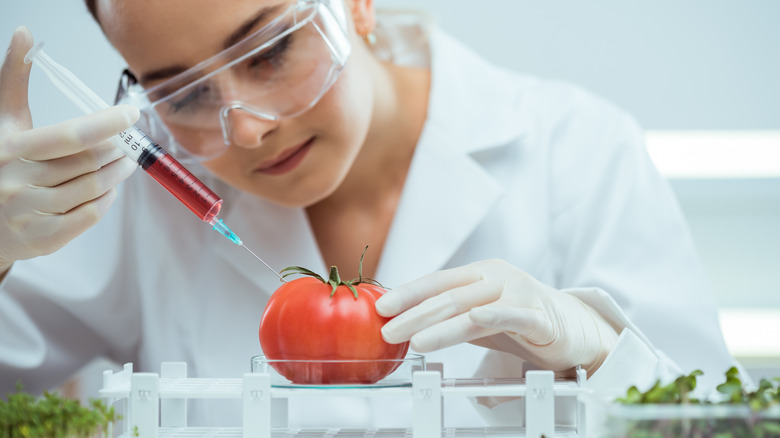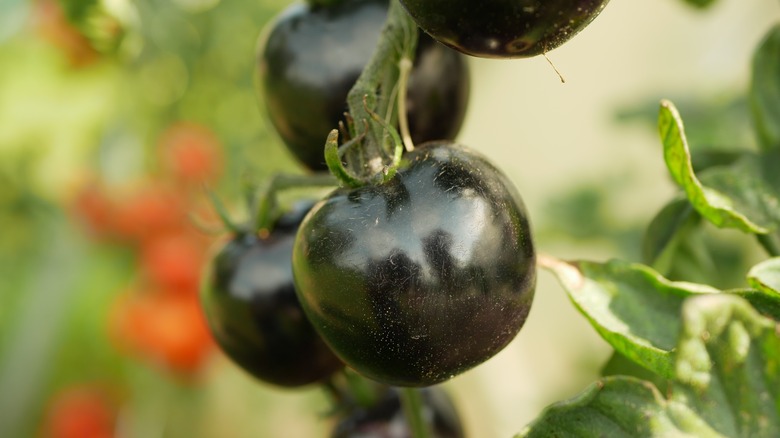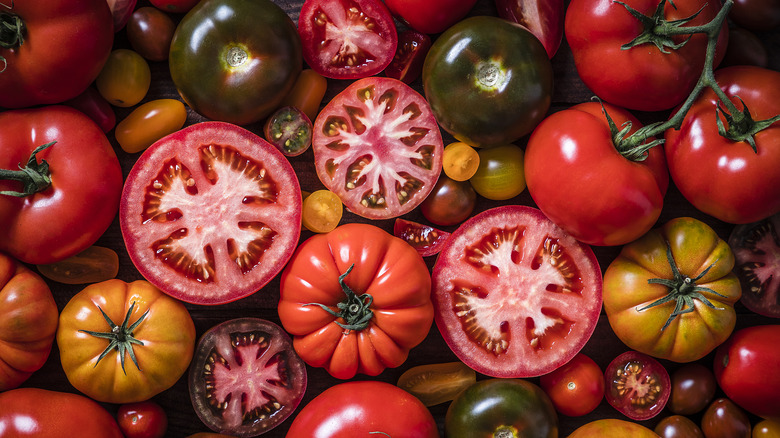Should You Grow Genetically Modified Tomatoes In Your Garden?
It's been over 20 years since a genetically modified tomato hit the market, and that one was not available to grow in home gardens. In 1997, the Flavr Savr tomato was commercially grown and available in supermarkets, but it was short-lived because it cost more to grow than its conventional competition, and, well, it simply didn't taste good. Now, for the first time ever, genetically modified tomato seeds will be available to the public. Simply named "Purple Tomato," this is not only the first tomato seed available to home growers, but the first genetically modified food crop ever to be developed and sold to individuals. This new tomato comes with some potential benefits and concerns.
Most people are aware of the debate surrounding genetically modified organisms, also known as GMOs. Until now, only commercial growers had access to these kinds of seeds, which include widely produced crops like cotton, corn, papaya, and more. Now, we can add tomatoes for home growers to that list, but are they really the answer to growing the best tomatoes in your garden?
What makes the Purple Tomato different
It has taken Norfolk Plant Sciences about 20 years to develop the Purple Tomato by adding edible snapdragon flower pigment genes to a tomato. The result is a dark, almost black, cherry tomato that, according to its creators, was developed to be high in anthocyanins. According to the National Institutes of Health, the pigmented snapdragon color compounds offer several health benefits, including antioxidant properties and immune support.
NPR reports that Norfolk Plant Sciences wants to support healthier consumers by using biotechnology to create more nutrient-dense, better-tasting food. The implication here is that the Purple Tomato is just the first step in that direction. In fact, the lead botanist on this project, Cathie Martin, stated in an interview with Fast Company that she would like to see other fruits developed with higher anthocyanin levels. While this feature sounds like a good idea, there are some concerns and questions about why there is a genetically modified tomato available to home growers, and what are the long-term implications.
Growing GMO tomatoes at home
The Purple Tomato was developed to be healthier and better tasting than conventional tomatoes, but is that something we need? With more than 10,000 varieties on the market, why would we decide to grow the single GMO option? Among those thousands of tomato types, there are already many heirloom purple and black tomatoes that are naturally high in anthocyanins and incredibly tasty. Favorite varieties among home gardeners include Black Krim, Cherokee Purple, and Blue Berries, which look almost identical to the GMO Purple Tomato.
As we consider growing these new types of tomatoes at home, there are a few things we don't know yet. Will these seeds cost more than a typical package of tomato seeds? Maybe they will cost less, making them more cost-effective. We do not know in what climates the Purple Tomato will grow best or if it stores well. Among the most concerning subjects is the possibility of cross-pollination. While tomatoes are less likely to cross-pollinate than some crops, it does happen. If the Purple Tomato cross-pollinates with another type of tomato in a garden, then those seeds are saved and planted, the genetically modified genes will be part of every future generation resulting from that seed. It is a lot to consider when you weigh the pros and cons. Ultimately, your decision may come down to whether you are excited about the future of bioengineered crops or if you want to keep your garden clear of genetically modified organisms.


